|
|
Philae Obelisk
| Present Site: | Kingston Lacy House & Park, Wimborne, Dorset, England N 50°48'34.9"(50.809695) W 2°01'57.8"(-2.032726) |
| Pharaoh: | Ptolemy IX (Ptolemaic Dynasty, Reigned 2-1 Century BC) |
| Measurement: | 3.66 meters high for obelisk itself Besides, a fragment with about 1 meter high (long). |
| Weight: | Estimated 6 tons |
| Stone: | Pink granite |
About The Site:
Kingston Lacy House & Park is a country house and estate, since Sir John Bankes who was Attorney General in the 17th Century owns this land. In 1981, it became to be managed by the National Trust, and is open publicly now.
The house is surrounded by a vast garden, forest, and croft, the land is 164 hectares. The main building in Kingston Lacy House is the Kingston Hall which was built in 1665. The inside is open to the public, there are many points of interests such as the Spanish Room, in which interior is splended, paintings of Rubens and Van Dyke, and the furnitures, etc. The obelisk stands in the vast garden which spreads in south side.
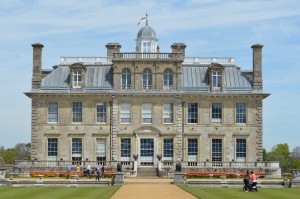 Kingston Hall
Kingston Hall
|
Sir John Bankes was born in 1786, is known as a friend of Byron (one of the greatest British poets), and also known as Egyptologist, Art collector, and traveler. He was a typical British aristocracy, went to Trinity College of Cambridge from Westminster School.
How To Get There:
Kingston Lacy House & Park is located in the suburbs of Wimborne, Dorset, in southern England. It's inconvenient to go there. In the case of public transportation from London, go to Poole or Bournemouth by train, and go to Wimborne Square by bus, and then Kingston Lacy by taxi. It takes more than 3 hours in total.
I went to Kingston Lacy from London by rented a car, it also took almost 3 hours due to the a traffic jam in highway. When you rent a car, I think the car navigation system is essential, because it becomes difficult to see the road when it comes to near Wimborne.
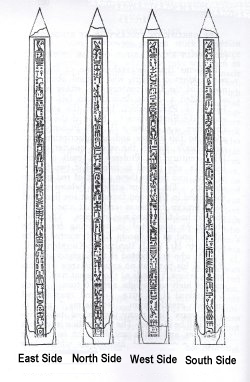 Inscriptions
InscriptionsI added the four directions on the original illustration by Wallis Budge |
About The Obelisk:
This obelisk was found in the ruin of Isis Temple in Philae Island, near Aswan, in 1815 by Giovanni Belzoni, an Italian explorer, Then John Bankes bought and transported it to England. There is an another story that John Bankes found it, and hired Giovanni Belzoni for transportation to England. Anyway, the obelisk arrived to England in 1821. The names of Ptolemy IX (Ptolemaic Dynasty, Reigned three times in 2-1 Century BC), his wife Cleopatra and his sister Cleopatra (name is same but a different person) are inscribed.
Importance: This obelisk is extremely important, because this played a decisive role in the decipherment of the hieroglyphs. Although it's well known that the Rosetta Stone and Champollion played key roles for the decipherment of hieroglyphics, but the decipherment was not be able to without this Philae Obelisk.
Many books say, Champollion referred to the Hieroglyph, Demotic, Greek Language, inscribed on the Rosetta Stone, and he successfully identified the phonogram for p, t, l, o, etc. with comparing the cartouches of Ptolemy and Cleopatra. However, the name of Cleopatra doesn't appear on the Rosetta Stone, but only the king name of Ptolemy is repeated.
In addition to the hieroglyphs on the obelisk, the Greek was inscribed on the pedestal. Although this was not accurately transcripted the hieroglyph inscription into Greek, but the similar contents were written. And, the names of Ptolemy and Cleopatra were here. John Bankes copied the hieroglyphs and Greek of them, and distributed it to many Egyptologists in various countries. Champollion who saw it, was able to compare with the hieroglyph of Cleopatra.
 Inscriptions in Greek, upper right portion of the south face of pedestal
Inscriptions in Greek, upper right portion of the south face of pedestalLetters of ΚΛΕΟΠΑΤΡΑ can be seen |
Since the climate in England and dried Egypt are largely different, this obelisk have unfortunately weathered from being carried on here. When I visited here in Summer 2014, the obelisk had been turned black with liverwort. Inscription of hieroglyphs is also there that it has not been originally deep engraving, it was hardly to see it. The sentence of the Greek which was inscribed on pedestal, even the existence was not understandable.
Just after my visit in 2014, the detailed research "Revealing the Inscriptions on an Egyptian Obelisk" was done by the cooperation of Department of Classics, Oxford University and 3 other organizations with an advanced digital technology. The cleaning of the obelisk was probably done at this time, particularly the south side was cleared, and the Greek inscriptions on the south side of pedestal was very clear, and I could confirm the Greek letters by eyes.
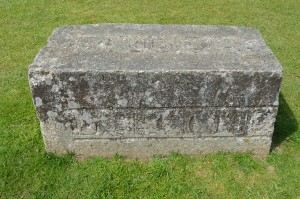 The frangment of broken obelisk
The frangment of broken obelisk
|
The current state of inscriptions is deteriorated, but the copy which was made when the the weathering did not progress remains. This can be seen in the book "Cleopatra's Needles and Other Egyptian Obelisks" by Wallis Budge. (See right. For high definition image, please click the picture.) I added the note; east - north - west - south. The cartouches of Cleopatra seems to be at the middle of north side, but it's difficult to confirm by eyes.
Not only the obelisk, John Bankes obtained also a large stone coffin, sphinx, stela (stone tablet) and so on. In addition, in later year, John Bankes obtained another broken obelisk, about 1 meter long. In the south garden which the obelisk stands, the stone coffin, sphinx, and the broken obelisk are placed. (and in the basement of Kingston Hall, the stela and shabti (or Ushabti, funerary figurine) are exhibited.) When I visited here again in 2016, the broken obelisk was also cleaned, and the inscription was readable. Comparing with the inscriptions of the standing obelisk, I confirmed this (right picture, also south side of the obelisk picture below) is the same of east side, bottom of it.
The Isis Temple of Philae Island was expected to be completely submerged after the Aswan High Dam was completed. So, the Isis Temple was relocated to the neighboring island of Agilka. Then, Agilka was renamed to Philae Island.
Here is an episode. On 12 November 2014, for the first time in history, the European Space Agency's landing module has successfully touched down on the comet. The name of landing module was Philae, and the robotic spacecraft was Rosetta. Of course, the names were derived from the story of the decipherment of the hieroglyphs. With this achievement, the name of Philae and Rosetta became well-known.
Notes For Pictures:
When I visited in 2014, I was only interested in the obelisk, and I didn't know the collections in the Kingston Hall. and I missed the pair marble obelisks. Then I visited here again in 2016, and confirmed the one of pair in the exhibition room in basement. But I couldn't see another pair because this was removed with unknown reason. It's about 40 cm long, and the engraved ones were a kind of design imitated by the hieroglyphs, probably made in modern age. The picture is here.
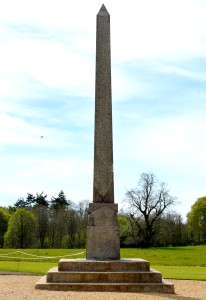 North Side |
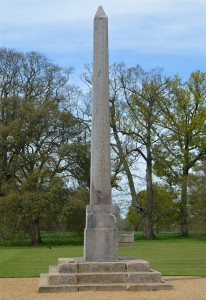 East Side |
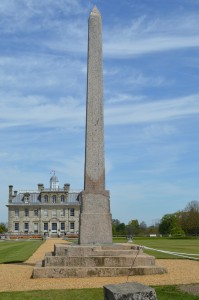 South Side |
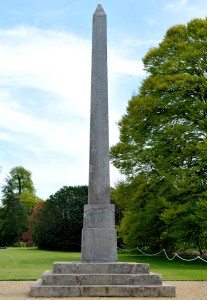 West Side |
|||
May 6, 2016 by Hiroyuki Nagase (For high definition image, please click the picture) | ||||||
Copyright Hiroyuki Nagase nagase@obelisks.org and Shoji Okamoto okamoto@obelisks.org